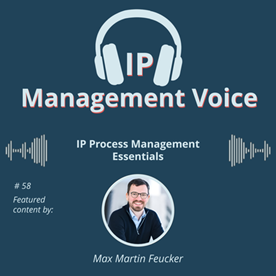IP Process Management: Turning Organizational Structures into Business Resilience
In today’s knowledge economy, intellectual property (IP) has become far more than a legal safeguard. It is the structural backbone of competitive advantage. Yet, many companies still treat IP as a legal necessity rather than a managed valuable asset.
What most business leaders don’t realize: introducing IP processes is easier than they think.
If a company already runs on structured business processes for product development, quality management, or compliance, then it already has the foundation for IP Process Management. The same logic of documentation, responsibility, and continuous improvement applies.
This blogpost draws on insights from the 🎧IP Management Voice episode with Subject Matter Expert Max Feucker, exploring how IP Process Management builds on existing organizational structures to reduce IP risks, create value, and strengthen business resilience.
From Legal Formality to Strategic Infrastructure
Owning patents, trademarks, or design rights is only the beginning. The true value of IP lies in how strategic these rights are created, maintained, and connected to business goals. IP Process Management provides a systematic framework for doing just that.
Rather than reinventing the wheel, it extends existing business processes into the IP domain. Wherever your company already tracks projects, records deliverables, or manages approvals, similar steps can capture innovations, manage IP filings, and ensure IP compliance. The result: IP becomes an integral part of your organization’s operational framework.
Integrating IP into Existing Business Process Structures
Many organizations hesitate to start “IP Process Management” because it sounds complex or bureaucratic. In reality, it is a natural extension of what you already do.
If you have workflows for product development, stage-gate reviews, R&D documentation, or marketing approvals, you already have 80% of what IP processes need: defined roles and approval steps. By integrating the IP function with these existing structures you instantly gain basic IP processes without additional overhead. Examples are: adding an invention disclosure step in your product development pipeline or connecting trademark clearance to your product naming process.
This modular integration is why introducing IP processes is far simpler than building them from scratch. It’s about connecting dots, not creating bureaucracy.
Capturing Innovation: From Idea to Documentation
Every IP journey starts with a moment of creativity. A structured invention disclosure process ensures that each new insight, whether a process improvement or a breakthrough technology, is recorded with full technical context and inventor data.
Embedding this step into existing R&D reporting systems or digital project tools makes it nearly effortless. Instead of a separate workflow, invention capture becomes a normal part of how innovation is documented, reducing friction and ensuring that no valuable idea is lost.
Building and Protecting Brand Identity
Your brand identity is already managed through marketing, design, and product development workflows. Adding a trademark clearance checkpoint or a design filing step inside these established processes keeps IP protection aligned with business goals.
This means that protecting names, logos, and designs no longer requires extra administrative layers. It simply becomes another process step in how you launch new products or campaigns.
Managing the IP Portfolio as a Strategic Resource
Integrating IP portfolio management into existing product development cycles allows management to see IP as part of the company’s core assets. Instead of occasional legal reviews, IP portfolio analysis can be synchronized with quarterly business reviews or strategic planning meetings.
This approach doesn’t demand new structures. It uses the ones that already exist to connect IP with business goals. The outcome: more comprehensive insights and better resource allocation.
Reducing Risks Through Freedom to Operate analyses and Enforcement
When IP monitoring and FTO analyses are built into your standard risk management or product launch procedures, they become preventive rather than reactive tools. This ensures that potential legal risks are identified at the same stage where technical risks are already evaluated.
The simplicity lies in alignment: your teams don’t have to integrated themselves into an entirely new management system. They just expand their existing processes to include IP perspectives.
Trade Secret Management: Protecting What Shouldn’t Be Disclosed
Internal compliance frameworks, data protection rules, and IT security measures already exist in most organizations. Trade secret management builds directly on them.
Clear access rights, confidentiality agreements, and employee training programs can easily incorporate IP-specific elements, such as explaining what constitutes a “trade secret” and how it must be managed. The result: seamless integration, not duplication of processes.
Why Process Optimization Drives Financial Benefits
Once IP becomes part of a company’s established process architecture, optimization happens naturally. The same metrics used in other departments, e.g. cost, speed, quality, risk, can now be applied to IP workflows.
This makes financial benefits transparent: less rework, fewer missed deadlines, faster filings, and stronger market readiness. Optimized IP processes prevent litigation and shorten time-to-market, not by adding new management systems, but by using existing ones smarter.
Digital Tools: The Enabler of Scalable IP Management
Modern IP management software integrates easily with the digital ecosystem many companies already use. It acts as a connecting layer, not a replacement.
Centralized data, automated workflows, and comprehensible dashboards create transparency across departments. Instead of fragmented spreadsheets or siloed knowledge, all stakeholders access the same real-time information. IP management thus becomes a visible component of the broader digital transformation.
From Cost Center to Growth Engine
When IP processes align with existing business processes, they deliver results quickly. Employees adapt fast because the system feels familiar. Management gains insights without extra reporting steps. And IP teams can focus on long-term strategy instead of firefighting.
This is how IP management evolves from a cost factor into a growth enabler and how structured IP processes translate directly into business resilience.
 Looking Ahead
Looking Ahead
The next frontier in IP management isn’t about higher process complexity, but about smarter process integration. Companies that already operate with process discipline are only one step away from professional IP management. By embedding structured IP processes in their existing workflows, they can create new value without heavy investment or cultural resistance.
Listen to episode #58 of 🎧IP Management Voice with Max Feucker to learn how to integrate IP processes into your existing business infrastructure.


